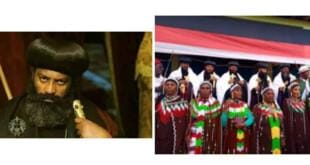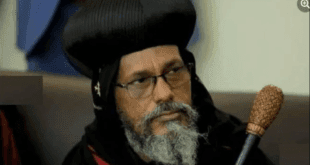The diaspora media movement shaping the coverage of Ethiopia’s protests
Source: http://qz.com/

Ademo, a journalist based in Washington DC, had for years strived to tell the world about the issues faced by his people, the Oromo, in Ethiopia. In 2008, he founded OPride, a website aimed at telling the stories of the growing Oromo diaspora and advocating for social justicein Ethiopia. In 2011, with the site’s readership growing, he went to study at the Columbia Journalism School, not because he wanted to become a journalist, but because he understood the power of the media as a tool to advocate for the Oromo cause.
But for years afterward, Ademo was dismayed that the Ethiopian government’s repression in Oromia, the country’s most populous region, didn’t warrant the attention of global media outlets.
Then in Aug. 2016, at the Rio Games, Lilesa did in a single moment what Ademo had been trying to do for years. The crossed wrists, a gesture of protest against Ethiopia’s government, brought the issue into the international conversation.
At that point the latest wave of unrest demanding economic and political reform had been ongoing for almost a year, and over 500 people had been killed in the process—nearly 100 in one weekend in August—according to human rights organizations. Lilesa said he was afraid of being imprisoned or killed if he went back to Ethiopia, and in early September, the US government granted him a special skills visa.
“These kinds of events don’t happen every day”
Ademo immediately reached out to the handlers of Lilesa, who were arranging for him to come to Washington DC. When he landed, with the help of a few colleagues, Ademo ensured that there was no fanfare at the airport, and whisked the athlete away. Together, they worked on figuring out how best to deliver a forceful message of protest. Ademo helped Lilesa prepare his first press release, worked with him during his exclusive interviews with the media, and stood next to him translating from Oromo when he gave a major press conference in front of the US Capitol building.
In just two days, there were more than 86 news articles and video clips about the marathoner and his cause, Ademo says. This was more media attention than countless protests in the past had garnered. “These kinds of events don’t happen every day,” says Ademo. Lilesa “opened so many doors that we’ve been knocking on for years.”
Ademo is part of a growing diaspora movement of writers, bloggers, journalists, and activists who have been shaping the coverage of Ethiopia’s recent protests. With no press freedom and facing a blanket shutdown of mobile internet and the banning of posting on social media in Ethiopia, these activists in the diaspora have often been the only source of news of the protests.
Using their contacts in Ethiopia, diaspora activists have flooded Twitter and Facebook with videos and photos disputing what they say are inaccurate accounts of protests pushed out by the mostly state-owned media in Ethiopia. Most recently at a bloody Thanksgiving festival, the government claimed 55 people died, but the activists say it was more like 300, and countless others injured.

The diaspora leadership network “that has now emerged has significant influence over the form and direction taken by protests in Oromia” region, says Jordan Anderson, an Africa analyst at IHS Markit, a global government and economic consultancy. For example, some foreign activists have provided strategic and tactical information via social media and in different languages to the protestors on the ground.
Ethiopia’s government is cognizant of the role of this foreign-based media in the growing unrest in the country. At the UN General Assembly in September, prime minister Hailemariam Dessalegn decried the use of social media, saying it has “empowered populists and other extremists to exploit people’s genuine concerns and spread their message of hate and bigotry without any inhibition.”
The state labeled both channels as “belonging to terrorist organizations”
And in early October, as part of the six-month, nationwide emergency, the government banned the viewing of Oromia Media Network and Ethiopian Satellite Television. The state labeled both channels, which are based outside the country and command huge viewership, as “belonging to terrorist organizations.” Both outlets have so far been able to circumnavigate the ban, and continue to produce original reporting based on information collected by and disseminated through the public.
Given the plethora of information now available about the government’s crackdown, the current concern is whether it will unite or further divide protesters both at home and abroad. After months of Oromo protests, the Amhara community also started agitating for their own rights, calling for the the government to move a section of their traditional homeland currently administrated by the Tigray regional state into the nearby Amhara region.
The two communities combine to make up more than 61% of the country’s over 100 million population. The Tigray, who make up 6.1% of the country, have dominated the government for decades now.
But the Oromo and Amhara communities’ competing claims and interests could undermine the protest movement, Anderson warns. Some Amhara groups, he says, still espouse the pro-imperial views that undermined the Oromo cultural and linguistic identity in the pre-1974 Amhara-dominated empire. Ethiopia was ruled by King Haile Selassie until a Communist military junta overtook the country in 1974. Other Amhara protesters also oppose Oromo claims over the capital Addis Ababa.
“Talks amongst diaspora activists and elites, and joint Oromo-Amhara rallies in the diaspora, are unlikely to bridge the gap between the Oromo and Amhara protesters inside Ethiopia,” Anderson says.
Ademo says it will take time to create trust and develop a unifying message that opposes Ethiopia’s current regime and appeals to both Oromo and Amhara protest groups. But he thinks it’s a reality, because “there is goodwill and expressions of solidarity. People are listening to each other more than in the past.”

Hassen Hussein, a Horn of Africa analyst and assistant professor at St. Mary’s University of Minnesota, says the magnitude of repression and the growing number of frustrated young people will transcend historical and ethnic differences. “The sheer size of the number of people being killed, detained and wounded is so overwhelming that the Oromo cause has won moral support among the Amhara and the other communities from Ethiopia,” says Hussein. There’s a growing awareness “that our fates are tied together, we need to work across the ethnic and whatever divide there is, and we have to work for a future that would be available to all of us.”
Lilesa has already become a symbol of that sort of unity. The whole of Ethiopia cheered him on in Rio, and when he turned the moment where he captured the Olympic silver medal into a political statement, it resonated widely: Ademo says that Lilesa’s welcoming party in Washington DC attracted more than 500 Ethiopians from all ethnicities.




